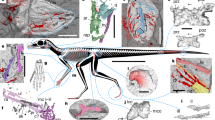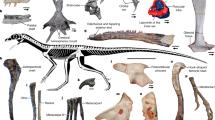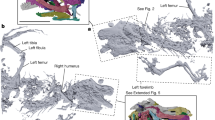Abstract
Maniraptora includes birds and their closest relatives among theropod dinosaurs1,2,3,4,5. During the Cretaceous period, several maniraptoran lineages diverged from the ancestral coelurosaurian bauplan and evolved novel ecomorphologies, including active flight2, gigantism3, cursoriality4 and herbivory5. Propagation X-ray phase-contrast synchrotron microtomography of a well-preserved maniraptoran from Mongolia, still partially embedded in the rock matrix, revealed a mosaic of features, most of them absent among non-avian maniraptorans but shared by reptilian and avian groups with aquatic or semiaquatic ecologies6,7,8,9,10,11,12,13,14. This new theropod, Halszkaraptor escuilliei gen. et sp. nov., is related to other enigmatic Late Cretaceous maniraptorans from Mongolia15,16 in a novel clade at the root of Dromaeosauridae17. This lineage adds an amphibious ecomorphology to those evolved by maniraptorans: it acquired a predatory mode that relied mainly on neck hyperelongation for food procurement, it coupled the obligatory bipedalism of theropods with forelimb proportions that may support a swimming function, and it developed postural adaptations convergent with short-tailed birds.
This is a preview of subscription content, access via your institution
Access options
Access Nature and 54 other Nature Portfolio journals
Get Nature+, our best-value online-access subscription
$29.99 / 30 days
cancel any time
Subscribe to this journal
Receive 51 print issues and online access
$199.00 per year
only $3.90 per issue
Buy this article
- Purchase on Springer Link
- Instant access to full article PDF
Prices may be subject to local taxes which are calculated during checkout




Similar content being viewed by others
References
Gauthier, J. Saurischian monophyly and the origin of birds. Memoirs Cal. Acad. Sci. 8, 1–55 (1986)
Witmer, L. M. in Mesozoic Birds: Above the Heads of Dinosaurs (eds Chiappe, L. M. & Witmer, L. M. ) 3–30 (Univ. California Press, 2002)
Xu, X., Tan, Q., Wang, J., Zhao, X. & Tan, L. A gigantic bird-like dinosaur from the Late Cretaceous of China. Nature 447, 844–847 (2007)
Holtz, T. R. Jr. The arctometatarsalian pes, an unusual structure of the metatarsus of Cretaceous Theropoda (Dinosauria: Saurischia). J. Vertebr. Paleontol. 14, 480–519 (1995)
Zanno, L. E. & Makovicky, P. J. Herbivorous ecomorphology and specialization patterns in theropod dinosaur evolution. Proc. Natl Acad. Sci. USA 108, 232–237 (2011)
Massare, J. A. Swimming capabilities of Mesozoic marine reptiles: implications for method of predation. Paleobiology 14, 187–205 (1988)
Meylan, P. A. Skeletal morphology and relationships of the early Cretaceous side-necked turtle, Araripemys barretoi (Testudines: Pelomedusoides: Araripemydidae), from the Santana Formation of Brazil. J. Vertebr. Paleontol. 16, 20–33 (1996)
Charig, A. J. & Milner, A. C. Baryonyx walkeri, a fish-eating dinosaur from the Wealden of Surrey. Bull. Nat. Hist. Mus. Lond. (Geol.) 53, 11–70 (1997)
Caldwell, M. W. From fins to limbs to fins: limb evolution in fossil marine reptiles. Am. J. Med. Genet. 112, 236–249 (2002)
Thewissen, J. G. M. & Taylor, M. A. in Fins into Limbs: Evolution, Development, and Transformation (ed. Hall, B. K. ) 310–322 (Univ. Chicago Press, 2007)
Habib, M. The structural mechanics and evolution of aquaflying birds. Biol. J. Linn. Soc. 99, 687–698 (2010)
Foffa, D., Sassoon, J., Cuff, A. R., Mavrogordato, M. N. & Benton, M. J. Complex rostral neurovascular system in a giant pliosaur. Naturwissenschaften 101, 453–456 (2014)
Barker, C. T., Naish, D., Newham, E., Katsamenis, O. L. & Dyke, G. Complex neuroanatomy in the rostrum of the Isle of Wight theropod Neovenator salerii. Sci. Rep. 7, 3749 (2017)
Kear, B. P., Larsson, D., Lindgren, J. & Kundrát, M. Exceptionally prolonged tooth formation in elasmosaurid plesiosaurians. PLoS ONE 12, e0172759 (2017)
Osmólska, H. Hulsanpes perlei n.g. n.sp. (Deinonychosauria, Saurischia, Dinosauria) from the Upper Cretaceous Barun Goyot Formation of Mongolia. Neues Jahrb. Geol. Paläontol. Monat. 7, 440–448 (1982)
Turner, A. H., Pol, D. & Norell, M. A. Anatomy of Mahakala omnogovae (Theropoda: Dromaeosauridae), Tögrögiin Shiree, Mongolia. Am. Mus. Nov. 3722, 1–66 (2011)
Turner, A. H., Makovicky, P. J. & Norell, M. A. A review of dromaeosaurid systematics and paravian phylogeny. Bull. Am. Mus. Nat. Hist. 371, 1–206 (2012)
Osmólska, H., Roniewicz, E. & Barsbold, R. A new dinosaur, Gallimimus bullatus n. gen., n. sp. (Ornithomimidae) from the Upper Cretaceous of Mongolia. Palaeontol. Pol. 27, 103–143 (1972)
Balanoff, A. M. & Norell, M. A. Osteology of Khaan mckennai (Oviraptorosauria: Theropoda). Bull. Am. Mus. Nat. Hist. 372, 1–77 (2012)
Xu, X. et al. A bizarre Jurassic maniraptoran theropod with preserved evidence of membranous wings. Nature 521, 70–73 (2015)
Ostrom, J. H. Osteology of Deinonychus antirrhopus, an unusual theropod from the Lower Cretaceous of Montana. Peabody Mus. Nat. Hist. Bull. 30, 1–165 (1969)
Cau, A., Brougham, T. & Naish, D. The phylogenetic affinities of the bizarre Late Cretaceous Romanian theropod Balaur bondoc (Dinosauria, Maniraptora): dromaeosaurid or flightless bird? PeerJ 3, e1032 (2015)
Gianechini, F. A., Makovicky, P. J. & Apesteguía, S. The teeth of the unenlagiine theropod Buitreraptor from the Cretaceous of Patagonia, Argentina, and the unusual dentition of the Gondwanan dromaeosaurids. Acta Palaeontol. Pol. 56, 279–290 (2011)
Xing, L. et al. Piscivory in the feathered dinosaur Microraptor. Evolution 67, 2441–2445 (2013)
Carpenter, K., Sanders, F., Reed, B., Reed, J. & Larson, P. Plesiosaur swimming as interpreted from skeletal analysis and experimental results. Trans. Kans. Acad. Sci. 113, 1–34 (2010)
Senter, P. Comparison of forelimb function between Deinonychus and Bambiraptor (Theropoda: Dromaeosauridae). J. Vertebr. Paleontol. 26, 897–906 (2006)
Ribak, G., Weihs, D. & Arad, Z. How do cormorants counter buoyancy during submerged swimming? J. Exp. Biol. 207, 2101–2114 (2004)
Hutchinson, J. R. The evolution of femoral osteology and soft tissues on the line to extant birds (Neornithes). Zool. J. Linn. Soc. 131, 169–197 (2001)
Gatesy, S. M. & Dial, K. P. Locomotor modules and the evolution of avian flight. Evolution 50, 331–340 (1996)
Goloboff, P., Farris, J. S. & Nixon, K. C. TNT, a free program for phylogenetic analysis. Cladistics 24, 774–786 (2008)
Acknowledgements
We thank the European Synchrotron Radiation Facility for granting us beam time at ID19 and BM05 beamlines; Y. Pommery for his work on teeth segmentation; T. Hubin for photographs; A. Halamski and D. Madzia for information on Hulsanpes holotype; and M. Auditore for the skeletal reconstructions. U. Lefèvre and L. Van Bossuyt took conventional X-ray pictures at the Veterinary School of Liège University. Silhouettes in Fig. 4a were provided by D. Bonadonna and L. Panzarin and are used with their permission. The program TNT was made available by the sponsorship of the Willi Hennig Society.
Author information
Authors and Affiliations
Contributions
A.C. and P.G. designed the project. P.G. supervised the preparation of the specimen. P.T., V.B., D.F.A.E.V. and V.F. performed synchrotron scanning, data processing and segmentation, and created the 2D and 3D renderings. K.S. conducted the histological analysis. R.B., K.T. and P.J.C. provided information on Mongolian theropods and geological setting. A.C. conducted the phylogenetic analyses. A.C. wrote the manuscript with input from all other authors.
Corresponding author
Ethics declarations
Competing interests
The authors declare no competing financial interests.
Additional information
Reviewer Information Nature thanks T. Holtz Jr and the other anonymous reviewer(s) for their contribution to the peer review of this work.
Publisher's note: Springer Nature remains neutral with regard to jurisdictional claims in published maps and institutional affiliations.
Extended data figures and tables
Extended Data Figure 1 Example of data processed with texture enhancement and metallic-inclusion correction algorithms.
a, Virtual section or the original dataset. b, Detail of a. c, Virtual section from the dataset corrected for metallic inclusions. d, Detail of c. Histograms along the blue and red lines demonstrate how metallic inclusions prevent adjusting the contrast to focus on the bone–matrix contact. e, Virtual section along the longitudinal axis of the cranium on dataset corrected for metallic inclusions. f, Detail of e. g, Same virtual section as in e, on data processed with the texture enhancement algorithm. h, Detail of g. In the processed data (g, h), homogenous parts (for example, bone or plaster) appear dark and the sediment reveals features that were barely visible prior to processing (e, f).
Extended Data Figure 2 Sectional slices that illustrate the integrity of MPC-D102/109.
a, Detail of anterior end of neck and posterior half of skull that shows continuity of the craniocervical transition. b, Detail of neck and skull that shows continuity between bones and matrix. c, Detail of proximal caudal series that shows the glued crack that crosses both matrix and bone (arrow), which confirms continuity between the sacrum and tail. d, Selected series of slices that show the continuity of bones and matrix along main slab. e, Overview of MPC-D102/109 indicating the curved virtual slice along a polyline (materialized above a 3D rendering) with slices at 5 mm on each side of this line every 1 mm. The line follows the axial column in order to show the continuity of the vertebral series. Scale bar, 70 mm. The renderings are generated using scan data that have been corrected for the absorbing metallic oxide infilling.
Extended Data Figure 3 Cross-sectional slices that illustrate the integrity of the left manus in MPC-D102/109.
a, Overview of MPC-D102/109 that indicates the location (red line) of the virtual sample for the slice shown in b. b, Dorsoventral cross-section of p2-I, p1-II and mc III; referred elements were stabilized close to their original position as indicated by the proximity of p2-I (grey arrow) to a small splint of p2-I that remained in the matrix (white arrow). Coloured lines indicate transects shown in c (blue), d (green) and e (purple). c, Mediolateral cross-section of manus with restored p2-I (grey arrow) indicated. d, Mediolateral cross-section of manus with in situ splint of p2-I (white arrow) indicated. e, Ventromedial–dorsolateral cross-section of manus with in situ splint of p2-I (white arrow) indicated. Scale bars, 20 mm. Sections in b–e were extracted from the dataset with an isotropic voxel size of 53.58 μm and volume reconstruction that followed a phase retrieval approach; b represents a single slice extracted from the digital volume and c–e were obtained through the thick-slab mode, with slab thickness set to 0.8 mm in ‘Maximum’ combine mode (VGStudio MAX 2.2.6, Volume Graphics).
Extended Data Figure 4 Cross-sectional slices reveal the consistent presence of a single line of arrested growth in the mandible and appendicular skeleton of MPC-D102/109.
a, Longitudinal sections of skull (left) and left mandibular ramus (right) of MPC-D102/109 that indicate the locations of the virtual samples for slices shown in b (blue) and c (red). b, Transverse section of left mandibular ramus. c, Longitudinal cross-section of left mandibular ramus in dorsoventral plane. d, Cross-section of left humerus at mid-shaft. e, Cross-section of right femur shaft. f, Cross-section of left femur shaft. g, h, Cross-sections of right tibia distal shaft. i, Cross-section of left tibia proximal shaft. j, Cross-section of right metatarsal IV proximal shaft. White arrows indicate lines of arrested growth (LAGs). Scale bars, 2 mm (a–c), 0.8 mm (d), 1 mm (e–h) and 0.9 mm (j). Sections in a–c were extracted from the dataset with an isotropic voxel size of 2.25 μm, and volume reconstruction that followed a phase retrieval approach, as single slices in VGStudio MAX 2.2.6. The section in d was extracted from the dataset with an isotropic voxel size of 2.2 μm and volume reconstruction that followed a phase retrieval approach, and then recoded for improved contrast with the thick-slab mode set to 100 μm in the ‘minimum’ combine algorithm of VGStudio MAX 2.2.6. Sections in e–j were extracted from the dataset with an isotropic voxel size of 53.58 μm and volume reconstruction that followed a phase retrieval approach, with the thick-slab mode set to 100 μm in the ‘minimum’ combine algorithm of VGStudio 3.0.2.
Extended Data Figure 5 Histology of MPC-D102/109 left tibia and fibula.
a, Interpretative histological drawing of tibia and fibula. b, Photomicrograph under cross-polarized light of boxed area in a. c, Cortical bone of the tibia under cross-polarized light with lambda waveplate, which reveals a LAG. d, Cortical bone of the tibia under cross-polarized light with lambda waveplate; this cross-section shows clearly the sharp cementing line boundary between the innermost remodelled and the outermost primary cortex. e, Close-up of the boxed area in d, with primary parallel-fibred bone with predominantly longitudinal canals and one LAG (white arrow) indicated. The cementing line that separates the outermost primary from the innermost remodelled cortex lies directly below the LAG. In the remodelled cortex, woven-bone osteocyte lacunae are visible in the lower left corner. No outer circumferential lamellae are visible. f, Close-up of the boxed area in d, with remodelled bone (black arrow) indicated. Several of the secondary osteons are surrounded by woven-bone osteocyte lacunae. A patch of inner circumferential lamellae is visible in the lower left corner. In panels a and d, b–f refer to their corresponding panels in the figure. Scale bars, 2 mm (a), 0.85 mm (b) and 0.35 mm (c–f).
Extended Data Figure 6 3D rendering of preantorbital part of the skull of MPC-D102/109.
a, Dorsal view. b, Palatal view. p11, 11th premaxillary tooth; m16, 16th maxillary alveolus. c, Semi-transparent left lateral view that shows dentition. d, Left lateral view. af, antorbital fossa; en, external naris; mr, maxillary recess; pms, premaxillo-maxillary suture. e, Semi-transparent right lateral view that shows dentition. f, Right lateral view. en, external naris; nf, neurovascular foramina. Scale bars, 3 mm.
Extended Data Figure 7 3D rendering of dentition of MPC-D102/109.
a, Premaxillary teeth in labial view. b, Premaxillary teeth in lingual view. c, Maxillary teeth in labial view. d, Maxillary teeth in lingual view. e, Maxillary teeth in basal view. f, Dentary teeth in lingual view. rt, replacement tooth. Scale bars, 1 mm.
Extended Data Figure 8 Comparison between synchrotron scan segmentations of the snouts of Crocodylus niloticus and H. escuilliei.
a–f, Synchrotron scan segments that show the enlarged bony chambers that house the blood vessels and the rostral terminations of the maxillary branch of the trigeminal nerves (red) in the snouts of a two-year-old C. niloticus (a, b), a twenty-year-old C. niloticus (c, d) and H. escuilliei MPC-D102/109 (e, f). Dorsal (a, c, e) and lateral views (b, d, f) are shown. Scale bar, 1.5 mm (a, b, e, f), 10 mm (c, d).
Extended Data Figure 9 Strict consensus of the shortest trees found by the analysis of first dataset.
a, Non-paravian taxa. b, Paraves. Numbers adjacent to nodes indicate decay index values >1 calculated when Hulsanpes and Shanag were pruned. DROMAEOSAUR., Dromaeosauridae; EUDRO., Eudromaeosauria; HALSZKAR., Halszkaraptorinae; MICROR., Microraptorinae; UNENLAG., Unenlagiinae.
Extended Data Figure 10 Reduced strict consensus of the shortest trees found by the analysis of the second dataset.
a, Non-pennaraptoran taxa; b, Pennaraptora. Numbers adjacent to nodes indicate decay index values >1.
Supplementary information
Supplementary Information
This file contains Supplementary Tables 1-2, Supplementary Text, Supplementary References and Supplementary Data – see contents page for details. (PDF 3874 kb)
Rights and permissions
About this article
Cite this article
Cau, A., Beyrand, V., Voeten, D. et al. Synchrotron scanning reveals amphibious ecomorphology in a new clade of bird-like dinosaurs. Nature 552, 395–399 (2017). https://doi.org/10.1038/nature24679
Received:
Accepted:
Published:
Issue Date:
DOI: https://doi.org/10.1038/nature24679
This article is cited by
-
Morphological disparity and structural performance of the dromaeosaurid skull informs ecology and evolutionary history
BMC Ecology and Evolution (2024)
-
A non-avian dinosaur with a streamlined body exhibits potential adaptations for swimming
Communications Biology (2022)
-
Intestinal preservation in a birdlike dinosaur supports conservatism in digestive canal evolution among theropods
Scientific Reports (2022)
-
Subaqueous foraging among carnivorous dinosaurs
Nature (2022)
-
Dinosaur biodiversity declined well before the asteroid impact, influenced by ecological and environmental pressures
Nature Communications (2021)
Comments
By submitting a comment you agree to abide by our Terms and Community Guidelines. If you find something abusive or that does not comply with our terms or guidelines please flag it as inappropriate.



